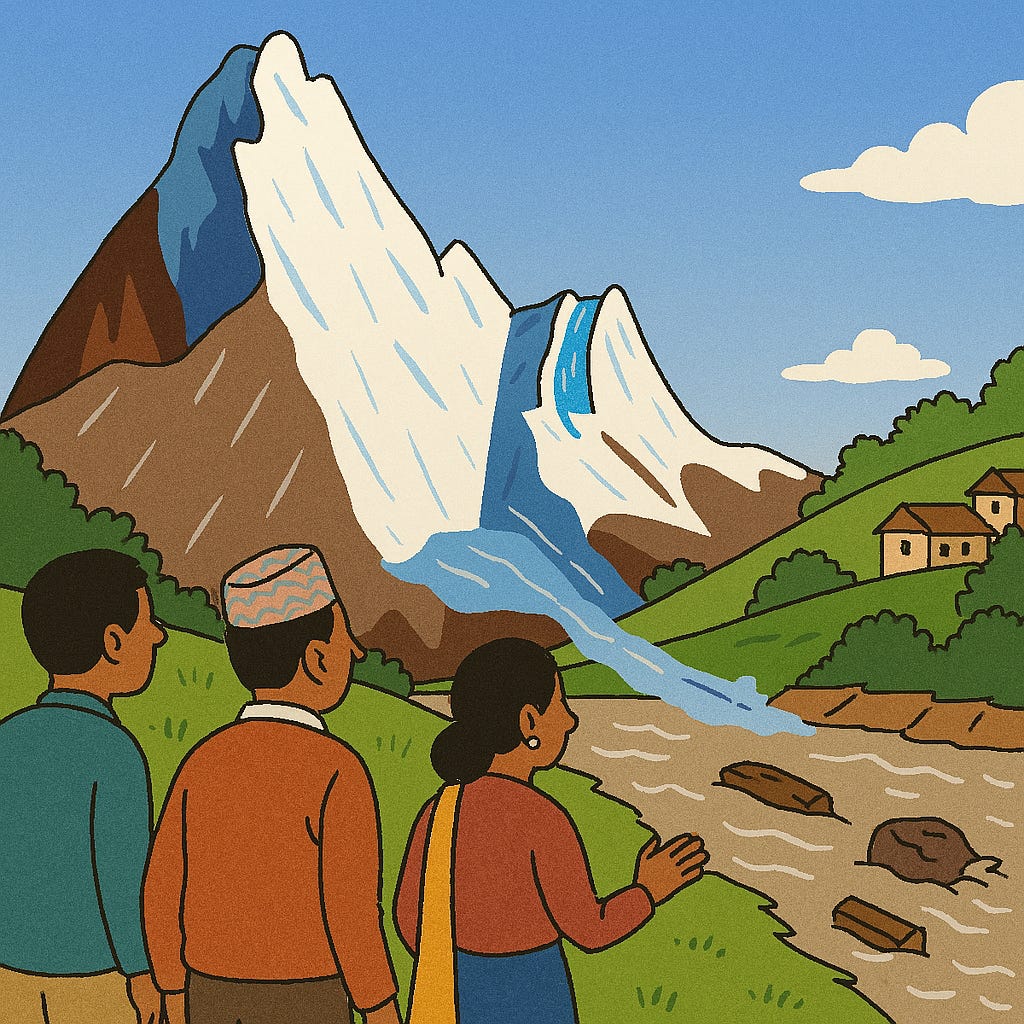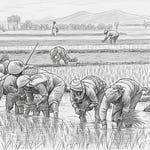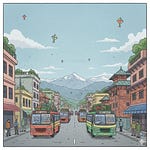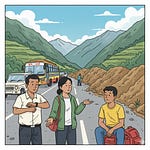Share the love! Help others that care about Nepal stay up to date the easy way. If you like this issue, share it with a friend who follows Nepal and hit Subscribe for your weekly dose of curated, can’t-miss updates.
Glacial floods, health boosts, and political chess moves—Nepal isn’t easing into the monsoon. As melting mountains trigger chaos and cooperation, doctors return to duty, party rivals circle each other, and pilgrims trek through flood-rerouted paths. From climate alarms to cross-border twists, here’s your weekly dose of the drama, resilience, and recalibration shaping Nepal.
Social & Cultural ⭐
A devastating glacial flood in Rasuwa has left at least nine people dead and 19 missing, while obliterating key infrastructure along Nepal’s northern border. Triggered by the sudden drainage of a supraglacial lake in Tibet, the torrent surged down the Lhende and Bhotekoshi rivers, sweeping away the Miteri Bridge, customs yards, hydropower stations, and container trucks at the Rasuwagadhi dry port. Over 1,100 meters of roadway were destroyed across ten points, according to KTM Post. Rescue operations are ongoing, with over 150 people—including 127 foreign nationals—airlifted to safety. Officials fear many of the missing, including six Chinese workers, may be buried under debris or swept into rivers that flow far downstream. THT adds that over 55 people were rescued on the first day alone, while 42 electric vehicles and multiple hydropower assets were damaged beyond repair.
Scientists are now warning that these floods are not isolated freak events, but signs of an accelerating climate threat. As explained by THT, Nepal saw two glacial lake outbursts within 24 hours—a pace that experts at ICIMOD call “completely unprecedented” in the Himalayas. Recent satellite data confirmed that the Rasuwa flood began after a newly formed lake near the Purepu Glacier suddenly drained. Officials from the Department of Hydrology and Meteorology say even smaller, short-lived lakes—undetectable on public satellite platforms—can now unleash disaster. TRN concurs, noting the need for real-time upstream alerts and greater investment in cross-border monitoring. Meanwhile, Republica reports that at least 250 MW of electricity has been cut off from the national grid due to flood damage at multiple plants.
Yet amid the damage, a remarkable coordination effort has unfolded. Security forces, local volunteers, and rescue teams have worked around the clock—constructing temporary trails, airlifting the stranded, and ensuring supplies reach cut-off villages. The incident has also triggered rare cross-border cooperation, with Chinese authorities allowing stranded pilgrims to reroute and some technical exchanges underway. Republica notes that nearly 900 people have already been evacuated, including families from high-risk zones. While the flood exposed real vulnerabilities, it’s also prompted a wider national conversation about climate readiness—and a renewed push to expand early warning systems beyond a handful of monitored lakes.
Heavy rains also triggered landslides and river surges in Taplejung, Myagdi, and Nawalparasi, killing several and displacing families across hilly districts. A KTM Post dispatch describes the Kanti Highway washed out and multiple bridges swept away in the east, stranding travellers for hours. In Jhapa, authorities are struggling to contain an outbreak of Lumpy Skin Disease, which has infected over 10,000 cattle, according to THT. Amid all this, Nepalis marked Gurupurnima, honouring teachers and mentors across schools and temples, and KTM Post reports that Lumbini has narrowly avoided landing on UNESCO’s World Heritage in Danger list, thanks to a year of focused conservation efforts and international cooperation.
Economy & Development 💸
In a much-needed boost to Nepal’s strained healthcare system, the government has doubled health insurance coverage for serious illnesses to Rs 200,000. The expanded scheme, announced by Minister for Health and Population Pradip Paudel, will take effect from the start of the new fiscal year on July 17. It covers treatment for eight life-threatening conditions including cancer, heart disease, kidney failure, spinal injuries, and Alzheimer’s. According to THT, the move is expected to ease financial burdens on thousands of households struggling to access critical care.
Meanwhile, Nepal’s digital economy is ending the fiscal year on a high note. Electronic transactions hit Rs 83.24 trillion in a single month—a record for Jestha—as reported by Republica. Nepal Rastra Bank data shows that Real-Time Gross Settlement (RTGS) systems drove the surge, supported by a last-minute spike in government spending. At the same time, TRN (link) reports progress in national power integration, with test production underway at the 220-kV Chimkhola-Rahughat transmission line in Myagdi. The line will connect nearly 130 MW of hydropower from four projects to the central grid—marking another step toward better energy distribution across the country.
Politics & Governance 🪧
After days of tension in hospitals nationwide, doctors have called off their protests following an agreement with the government over legal protections for medical professionals. The standoff began when the consumer court ordered several private hospitals to compensate patients in negligence cases, prompting the Nepal Medical Association to demand amendments to the Consumer Protection Act. In response, Prime Minister KP Sharma Oli directed three ministries to negotiate with protest leaders. The deal includes a task force to review policy reforms within a week, and regular medical services have now resumed, according to Nepal News. Meanwhile, KTM Post reports that Kathmandu Metropolitan City has finally tabled its Rs 25.11 billion budget after months of deadlock between Mayor Balendra Shah and federal authorities. The budget delay, sparked by a dispute over corruption allegations and control of the chief administrative officer’s post, had stalled city governance for over six months.
Political intrigue is brewing within the ruling UML, as former President Bidya Devi Bhandari’s return to active politics has reignited debate over party leadership. Bhandari is rumored to be positioning herself as a challenger to KP Sharma Oli’s bid for a third term as chairperson, despite the party’s age and term-limit rules. While Oli loyalists dismiss the challenge, party insiders suggest a deeper rift is forming between rival factions. KTM Post notes that the upcoming UML policy convention may prove decisive in resolving the power struggle. Separately, Nepal News reports that police summoned former King Gyanendra’s secretary for referring to him with the now-defunct title “His Majesty”—a reminder of the sensitivities surrounding Nepal’s post-monarchy political landscape. In economic governance, newly appointed NRB Governor Biswo Nath Poudel unveiled his first monetary policy aimed at stabilizing inflation and supporting struggling sectors through targeted credit, as reported by Nepal News.
Diaspora & Globalization 🌏
Nepalis heading abroad will soon have a little more flexibility when it comes to currency exchange. The government has raised the upper limit for foreign exchange to USD 3,000 per person for outbound travelers, up from the previous cap of USD 1,500. According to Republica, this change aims to ease the burden for students, migrant workers, and tourists navigating increasingly expensive global travel. The move has been welcomed by education consultancies and travel agents, though many say it’s still not enough to meet the full cost of study or relocation in many destinations.
Meanwhile, the Kailash Manasarovar Yatra has resumed after a five-year pause, bringing a wave of Indian religious tourists through Nepal. Tour operators told KTM Post they expect at least 25,000 Indian pilgrims this season—many of whom are booking Nepal as the transit route to Tibet. After the Rasuwa flood wiped out the main crossing at the Miteri Bridge, Chinese authorities allowed returning pilgrims to exit via Kodari and Hilsa. While the yatra offers major economic opportunity for Nepal’s travel industry, operators say visa processing bottlenecks and infrastructure damage could limit how much of the surge Nepal can actually serve.
Did you know ❓
Nepal’s first film censor board was established before it had a full film industry? In the 1950s, the government formed a censor body primarily to vet Indian films screened in Nepali theatres. It wasn’t until 1964 that Nepal produced its first full-length feature film, Aama, funded by the government.
Let’s connect
Enjoying this issue? 📩 Share it with a friend & let’s keep Nepalis worldwide in the loop! Got thoughts? Hit reply—we’re all ears! Or let us know what you think via our Feedback form or follow us on Facebook | LinkedIn
P.S. Got a story or issue you'd like us to cover next week? Drop us a reply — we're building this space together.
About Nepali Diaspora Digest:
The Nepali Diaspora Digest connects the global Nepali community with curated news, insights, and stories that matter most. Join us as we celebrate and explore the diverse voices and achievements of Nepalis worldwide.
Partner shout out
belayat.uk: helping Nepalis connect in the UK on jobs, housing, events and finding local Nepali owned businesses















